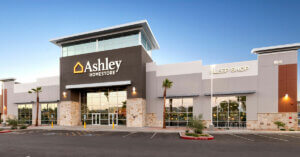Conversion Rate Optimization (CRO) Governance Simplified: 5 Models for Structured and Effective Optimization
By Haley Carpenter, Kait Willis
September 5, 2023
Share
Any system needs structure in order to function, be efficient, and generate results. Solid structures require strong foundations, supporting elements, and the ability to adapt to changes. Conversion rate optimization (CRO) is no different. It’s a ‘system’ within the bigger ‘system’ and should be implemented with intention so that it fits well within your already established operations.
As most of us know, CRO is a service that touches a multitude of branches within an organization. In some cases, initiatives may be centered around end-to-end user experience, while others are tasked specifically with landing page optimization. Regardless, a well-outlined governance structure must be in place in order for CRO efforts to be effective. Having defined responsibilities and allocated resources means you can better manage data, facilitate A/B testing, and cultivate a culture focused on iterative improvements aligned with overall business goals.
In this article, we’re sharing five governance models commonly seen in organizations that will help you build or improve your CRO program. Keep in mind factors such as budget, personnel, and time when considering what model is best for your organization. Know that hybrids are an option and that the same model can look different from organization to organization.
Model 1: Individual CRO Governance
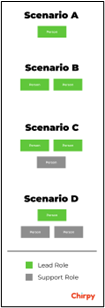
The Individual model is one that can exist in any size organization, large or small. This situation typically happens in one of two ways—either one or a few humans are tasked by higher-ups to start CRO or someone starts it through a grassroots effort. The level of knowledge by people involved here varies from knowing nothing or very little about CRO to being an expert. In personal experience, it’s usually the former.
This is the most undesirable format to have, but it’s better than nothing. If anything, it’s almost always a starting point to build off of as you grow the program. A good analogy is that it’s really like a CRO startup within an organization. It’s tight on budget, personnel, expertise, etc. It’s also usually difficult to scale—or it at least takes longer since it’s being built from the ground up.
Good option? No.
Pros:
- It’s a starting point
- There are few stakeholders so you can move quickly
- Having few stakeholders makes it easier to maintain rigor and organized efforts
Cons:
- Not scalable
- Fewer resources
- Less buy-in
Model 2: Centralized CRO Governance
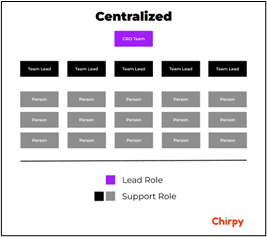
This is when there’s a fully dedicated CRO team. It’s all they do. They spend 100% of their time on it and run every part of the workflow for the entire organization. They’re responsible for the strategy, tactics, and rigor. They handle everything from research, ideation, mockups, and wireframes to launching A/B tests, analysis, reporting, and evangelization. They’re not responsible for other digital efforts like PPC, SEO, or creative, for example. Every CRO effort runs through this dedicated team. It’s one of the most ideal models as it allows for new discoveries and learnings to be shared easily across the entire company. There’s a high level of specialization since it’s the sole focus of the team. It’s easy to scale in the long run, although the short-term can take a little longer due to hiring and onboarding. It’s also easier to control rigor. One downside is that CRO specialists are typically expensive, at least in the U.S, so it can be more costly to execute.
Good option? Yes!
Pros:
- Dedicated resources, high level of specialization
- Scalable
- Easier to maintain rigor
Cons:
- Expensive to hire CRO specialists
- Resourcing can be an issue if you can’t keep up with hiring needs
- There is less involvement from the rest of the organization, reducing buy-in and others’ CRO knowledge
Model 3 & 4: Testing Council and Center of Excellence (CoE)
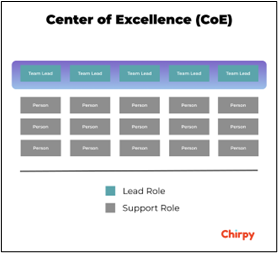
Testing Councils and CoEs can be quite similar to each other. Differences among each vary from organization to organization and can be subtle or very distinct. One could argue these are also types of a centralized model, since these have governing centralized groups of people. The types of responsibilities of each are really what differentiate these two, and each of these models has less responsibility than the centralized model with a dedicated CRO team.
A Council’s members are typically a group of team leads. They are a centralized, collaborative group responsible for more tactical decisions like choosing what gets done and when (e.g., which A/B tests to run, when to run them, etc.). CoEs are very similar, but they’re often focused on maintaining rigor, excellence, and processes (hence the name Center of Excellence). Unlike the Centralized model with a dedicated CRO team, anyone in a lead role in these models often has other digital responsibilities like brand, merchandising, PPC, etc.
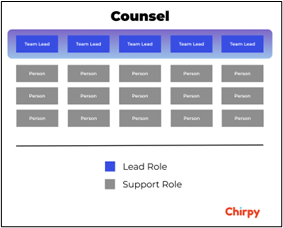
These models are often more affordable and faster to ramp up since hiring new, specialized CRO folks isn’t required. Knowledge sharing and collaboration are still abundant. Scaling is usually fairly easy. However, resourcing enough time for CRO can be problematic since leads usually have other responsibilities. In the Council model, rigor can also be more difficult to maintain if it is not a focal area across teams. In the CoE model, knowledge sharing can be lacking if it is not a focal area.
Good option? Yes!
Pros:
- Scalable
- Dedicated efforts for collaboration, coordination, and sometimes rigor maintenance
- Easy to add resources, cheaper to implement
Cons:
- Resourcing can be an issue if leads can’t keep up
- Less specialization
- Slow speed, if politics gets in the way
Model 5: Decentralized CRO Governance
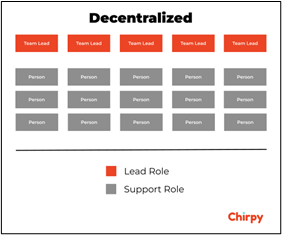
As you can probably guess, this model is basically the exact opposite of the Centralized model. Here, CRO is done in silos under each team with no collaboration or coordination among anyone or anything. This is usually not an ideal situation. However, if it’s a starting point, it’s better than nothing. Silver linings: it sometimes allows teams to go faster due to having fewer stakeholders. Plus, it is cheaper to implement since hiring isn’t required.
Good option? No.
Pros:
- Fast speed due to fewer stakeholders working together
- Scalable (kind of)
- Cheaper to implement
Cons:
- Lack of collaboration and knowledge sharing
- Less specialization
- Lack of rigor
So Which Model Should You Choose?
There is no one size fits all solution. The CRO governance model you choose should be intentional and scalable. Find the variation that works best for your company and your overall business goals. Like your optimization efforts online, work to make continuous improvements and adjustments with your team structure along the way. Take mistakes as learning opportunities and use that new information to guide improvements. Know that it often takes a while to get to the desired state—just start somewhere and go from there. (It’s certainly better than nothing or waiting forever.)
Discover how SiteSpect can help you reach your CRO goals—Book a demo to get started.
Share
Suggested Posts
Subscribe to our blog:




